Soft-Switching Bidirectional Three-Level DC–DC Converter with Simple Auxiliary Circuit
Abstract
:1. Introduction
2. Proposed Converter
2.1. Circuit Configuration
2.2. Control Operation
2.3. Soft-Switching Condition
3. Simulation and Experimental Results
3.1. Simulation Results
3.2. Experimental Results
3.3. Power Loss Analysis
4. Conclusions
Author Contributions
Funding
Conflicts of Interest
References
- Lin, C.C.; Yang, L.S.; Wu, G.W. Study of a non-isolated bidirectional DC-DC converter. IET Power Electron. 2013, 6, 30–37. [Google Scholar] [CrossRef]
- Sulake, N.R.; Venkata, A.K.D.; Choppavarapu, S.B. FPGA implementation of a three-level boost converter-fed seven-level dc-link cascade H-bridge inverter for photovoltaic applications. Electronics 2018, 7, 282. [Google Scholar] [CrossRef]
- Kim, J.Y.; Kim, H.S.; Beak, J.W.; Jeong, D.K. Analysis of effective three-level neutral point clamped converter system for the bipolar LVDC distribution. Electronics 2019, 8, 691. [Google Scholar] [CrossRef]
- Han, S.H.; Kim, H.G.; Cha, H.; Chun, T.W. Bi-directional multi-level converter for an energy storage system. J. Power Electron. 2014, 14, 499–506. [Google Scholar] [CrossRef]
- Mirzaei, A.; Farzanehfard, H.; Adib, E.; Jusoh, A.; Salam, Z. A fully soft switched two quadrant bidirectional soft switching converter for ultra-capacitor interface circuits. J. Power Electron. 2011, 11, 1–9. [Google Scholar] [CrossRef]
- Tan, L.; Wu, B.; Yaramasu, V.; Rivera, S.; Guo, X. Effective voltage balance control for bipolar-dc-bus-fed EV charging station with three-level dc-dc fast charger. IEEE Trans. Ind. Electron. 2016, 63, 4031–4041. [Google Scholar] [CrossRef]
- Tan, L.; Zhu, N.; Wu, B. An integrated inductor for eliminating circulating current of parallel three-level dc-dc converter-based EV fast charger. IEEE Trans. Ind. Electron. 2016, 63, 1362–1371. [Google Scholar] [CrossRef]
- Choi, W.Y.; Yang, M.K. High-efficiency design and control of Zeta inverter for single-phase grid-connected applications. Energies 2019, 12, 974. [Google Scholar] [CrossRef]
- Lee, H.J.; Kim, Y.H. Analysis and design of a ZVT resonant boost converter using an auxiliary resonant circuit. Electronics 2019, 8, 466. [Google Scholar] [CrossRef]
- Li, J.; Horck, F.B.M.; Daniel, B.J.; Bergveld, H.J. A high-switching-frequency flyback converter in resonant mode. IEEE Trans. Power Electron. 2017, 32, 8582–8592. [Google Scholar] [CrossRef]
- Xie, X.; Li, J.; Peng, K.; Zhao, C.; Lu, Q. Study on the single-stage forward-flyback PFC converter with QR control. IEEE Trans. Power Electron. 2016, 31, 430–442. [Google Scholar] [CrossRef]
- Li, Y.C. A novel control scheme of quasi-resonant valley-switching for high-power-factor ac-to-dc LED drivers. IEEE Trans. Ind. Electron. 2015, 62, 4787–4794. [Google Scholar] [CrossRef]
- Park, J.P.; Moon, Y.J.; Jeong, M.G.; Kang, J.G.; Kim, S.H.; Gong, J.C.; Yoo, C.S. Quasi-resonant controller with adaptive switching frequency reduction scheme for flyback converter. IEEE Trans. Ind. Electron. 2016, 63, 3571–3581. [Google Scholar] [CrossRef]
- Sergio, B.M.; Joan, N.A. A multilevel active-clamped converter topology – operating principle. IEEE Trans. Ind. Electron. 2011, 58, 3868–3878. [Google Scholar]
- Choi, W.Y.; Yang, M.K.; Suh, Y.S. High-efficiency supercapacitor charger using an improved two-switch forward converter. J. Power Electron. 2014, 14, 1–10. [Google Scholar] [CrossRef]
- Poorali, B.; Jazi, H.M.; Adib, E. Single-core soft-switching high step-up three-level boost converter with active clamp. IET Power Electron. 2016, 9, 2692–2699. [Google Scholar] [CrossRef]
- Wang, J.; Li, R.T.; Chung, H.S. An investigation into the effects of the gate drive resistance on the losses of the MOSFET-snubber-diode configuration. IEEE Trans. Power Electron. 2012, 27, 2657–2672. [Google Scholar] [CrossRef]
- Rodrigues, J.P.; Mussa, S.A.; Heldwein, M.L.; Perin, A.J. Three-level ZVS active clamping PWM for the DC-DC buck converter. IEEE Trans. Power Electron. 2009, 24, 2249–2258. [Google Scholar] [CrossRef]
- Rodrigues, J.P.; Mussa, S.A.; Barbi, I.; Perin, A.J. Three-level zero-voltage switching pulse-width modulation DC-DC boost converter with active clamping. IET Power Electron. 2010, 3, 345–354. [Google Scholar] [CrossRef]
- Wang, B.; Yuan, Y.; Zhou, Y.; Sun, X. Buck/boost bidirectional converter TCM control without zero-crossing detection. In Proceedings of the IEEE International Power Electronics and Motion Control Conference (IPEMC, 2016), Hefei, China, 22–26 May 2016. [Google Scholar]
- Wang, Y.; Yang, J.; Zhang, B.; Jiang, X.; Kang, Z.; Ni, T.; Li, W. TCM controller design for three-level bidirectional soft-switching dc-dc converter. In Proceedings of the IEEE International Symposium on Industrial Electronics (ISIE, 2019), Vancouver, BC, Canada, 12–14 June 2019; pp. 996–1001. [Google Scholar]
- Ang, S.; Oliva, A. Power Switching Converters; CRC Press: Boca Raton, FL, USA, 2011; pp. 1–488. [Google Scholar]
- Mohan, N. Power Electronics: A First Course; John Wiley & Sons: Hoboken, NJ, USA, 2012. [Google Scholar]
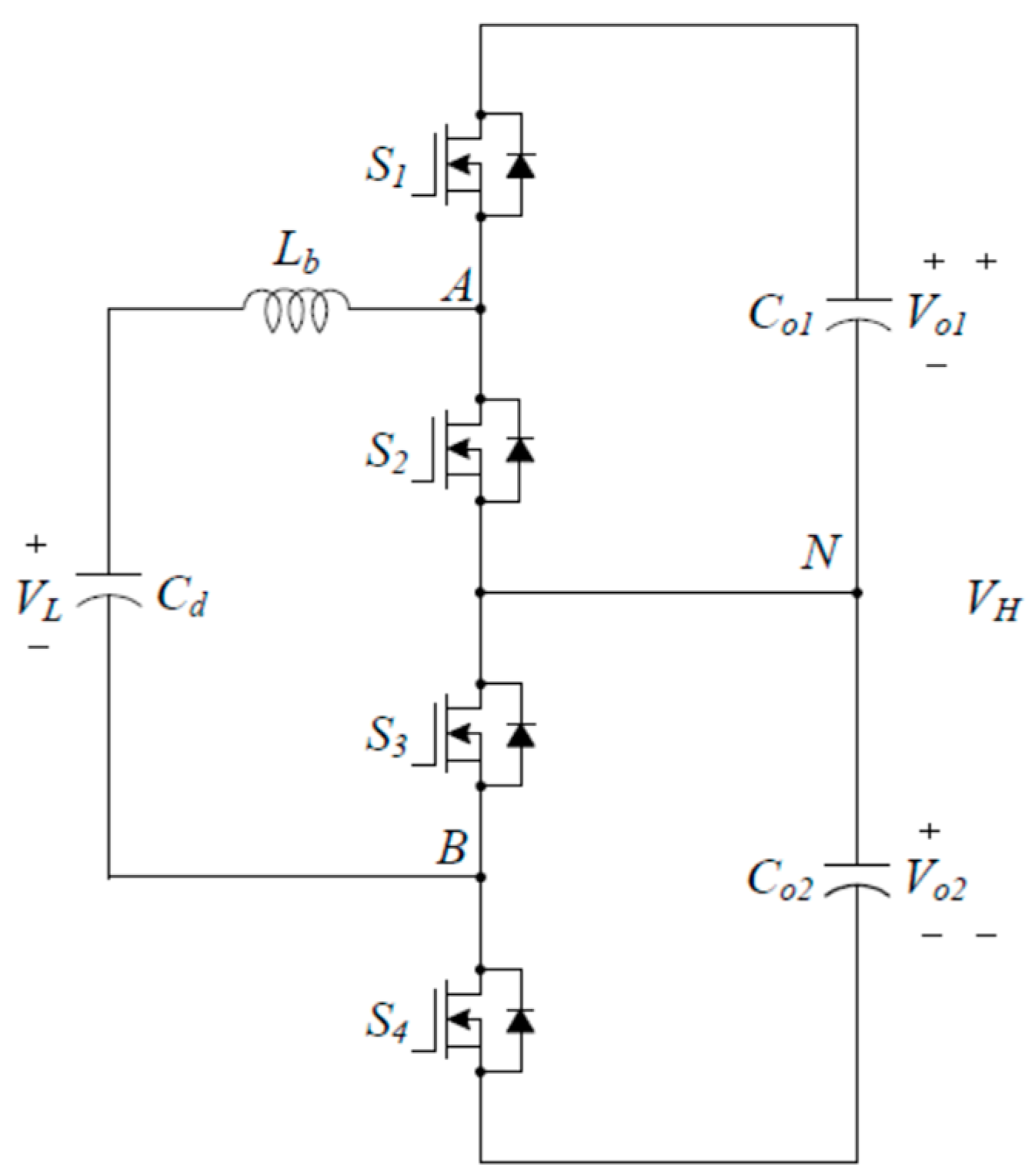
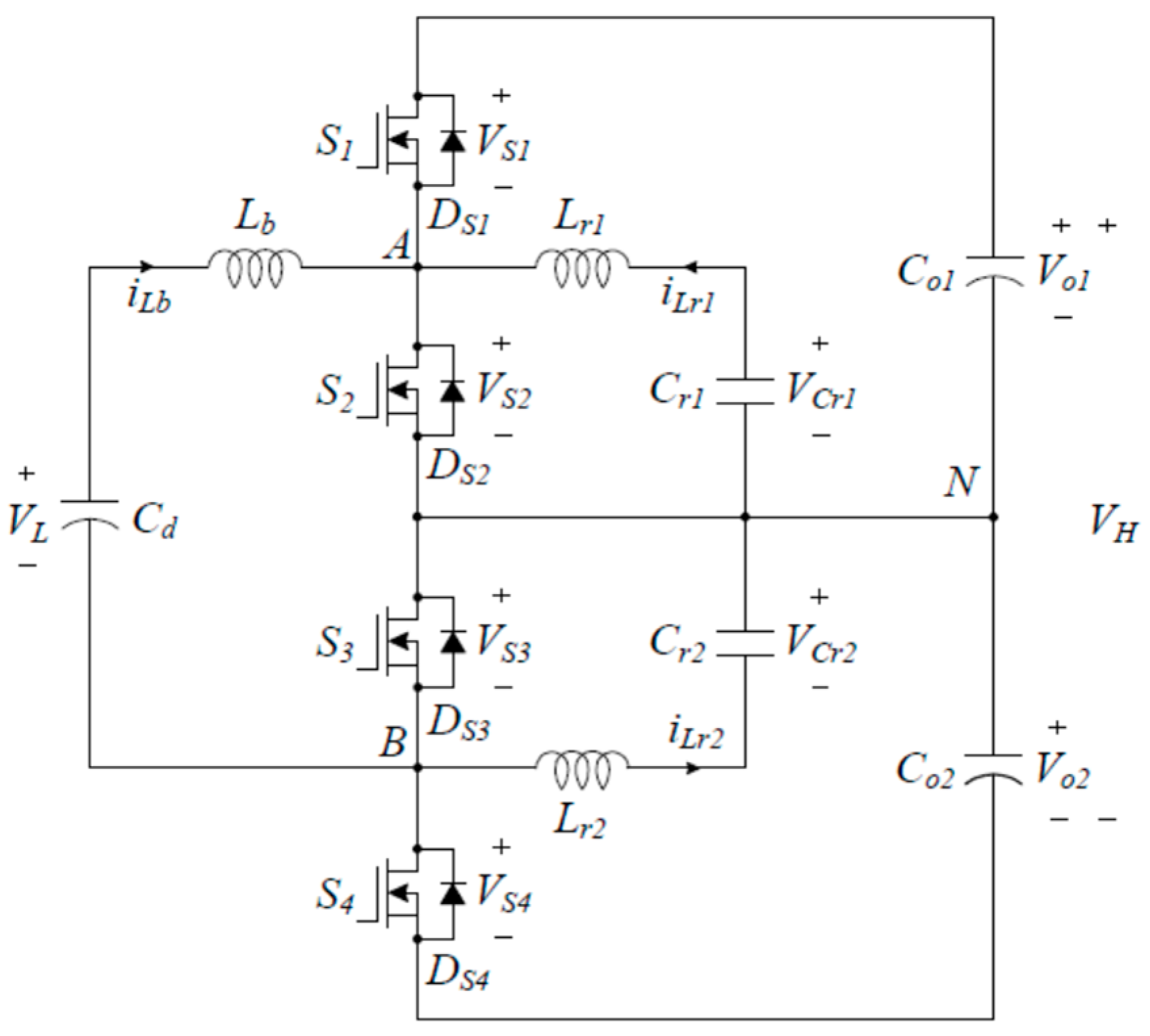
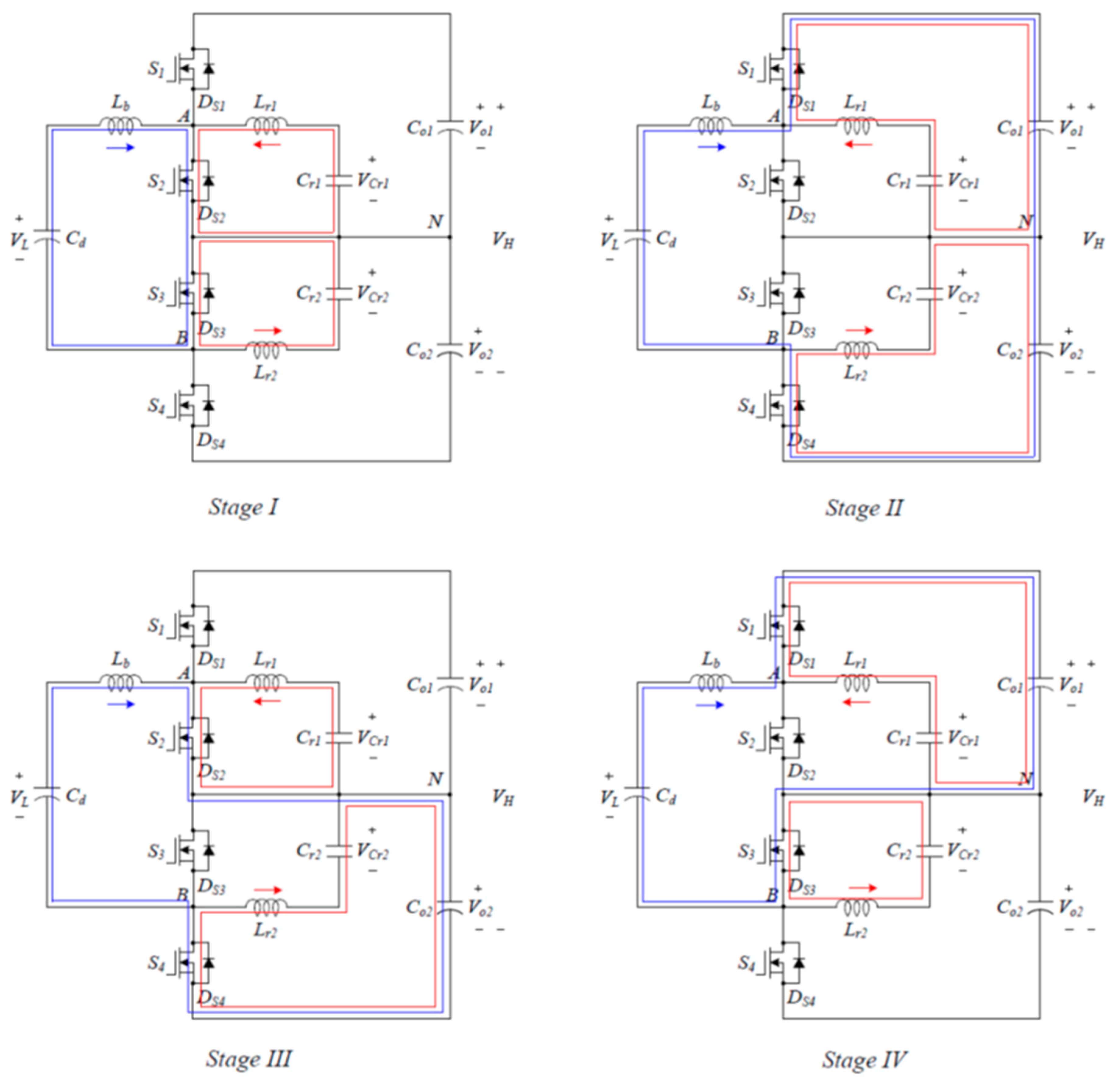
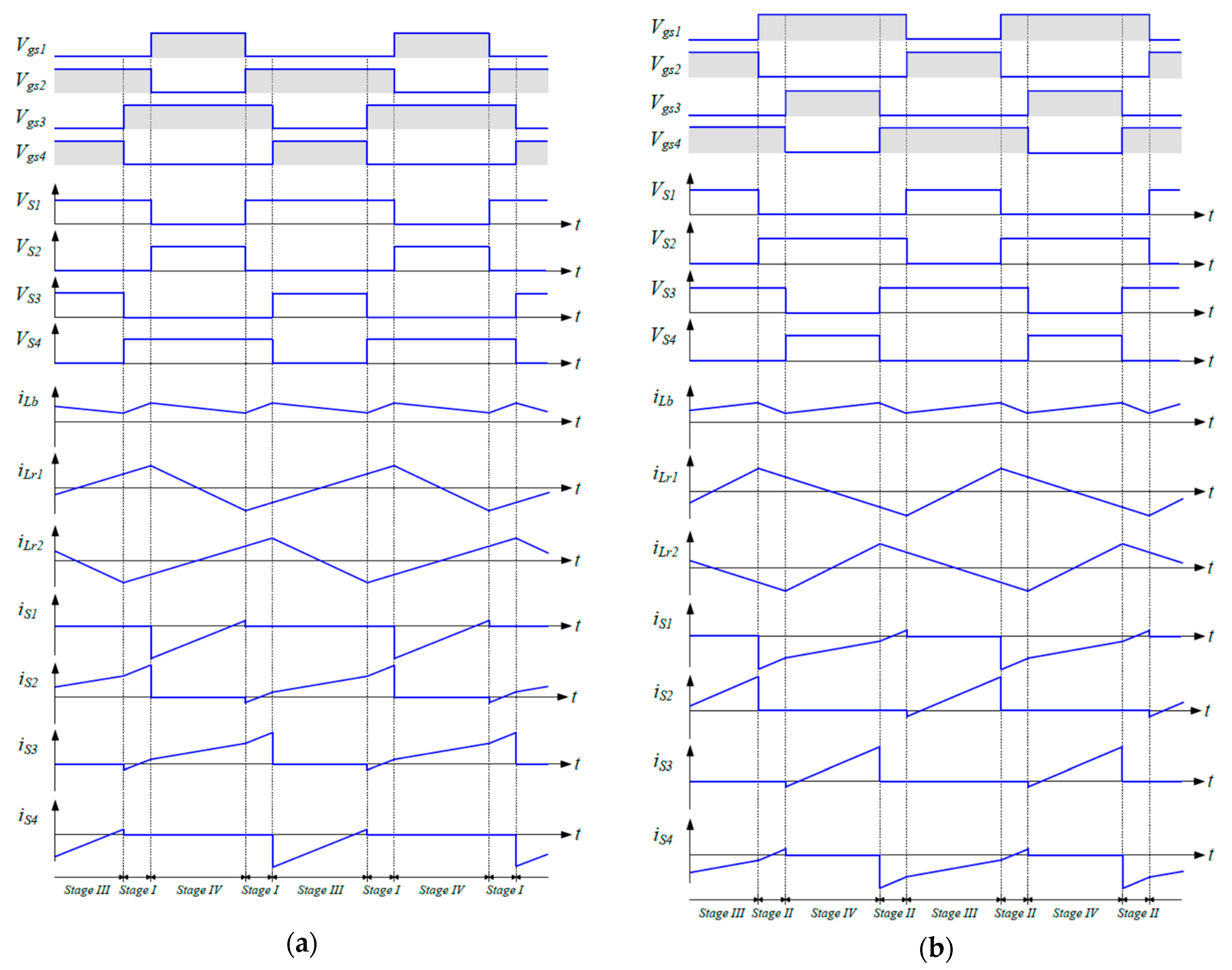
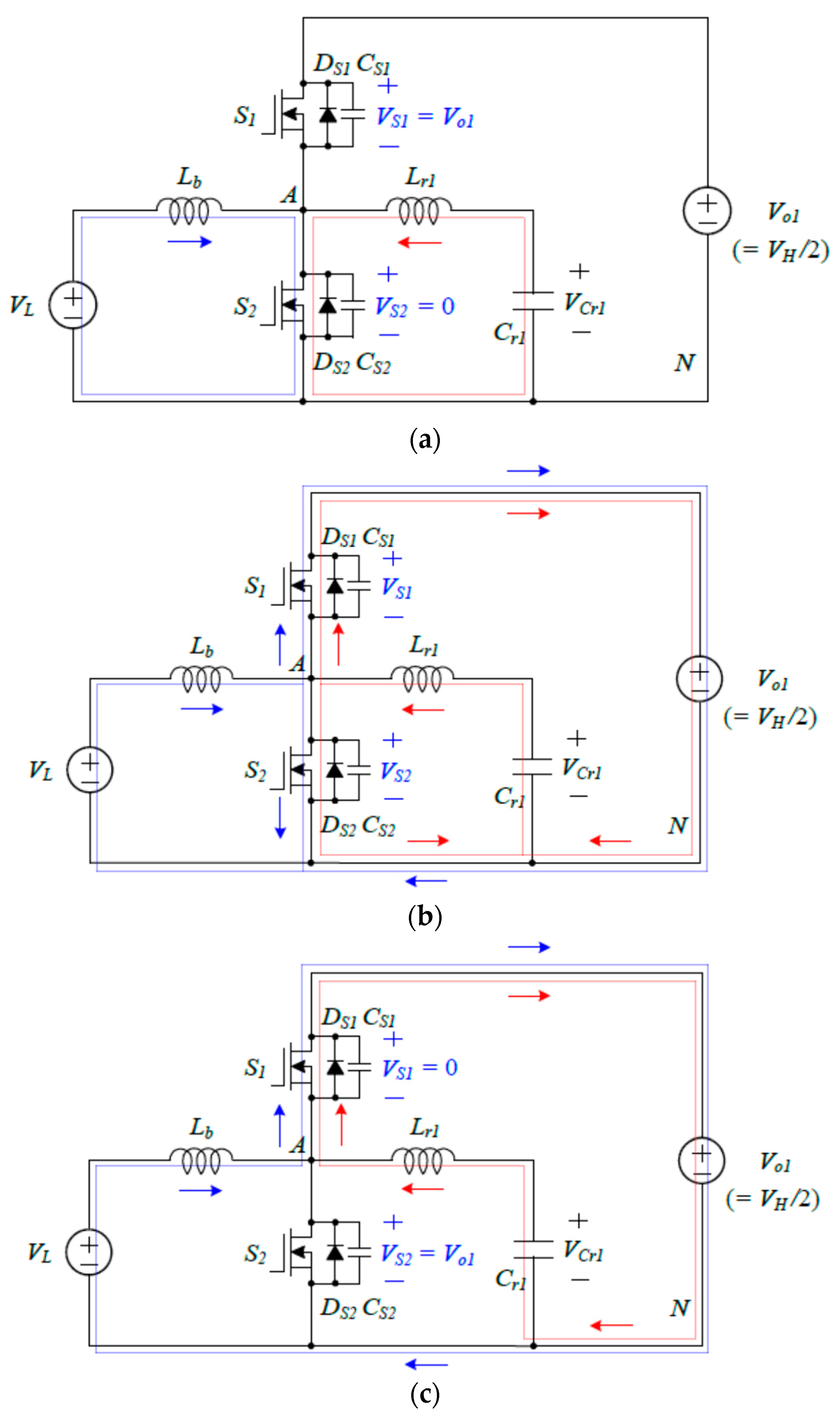
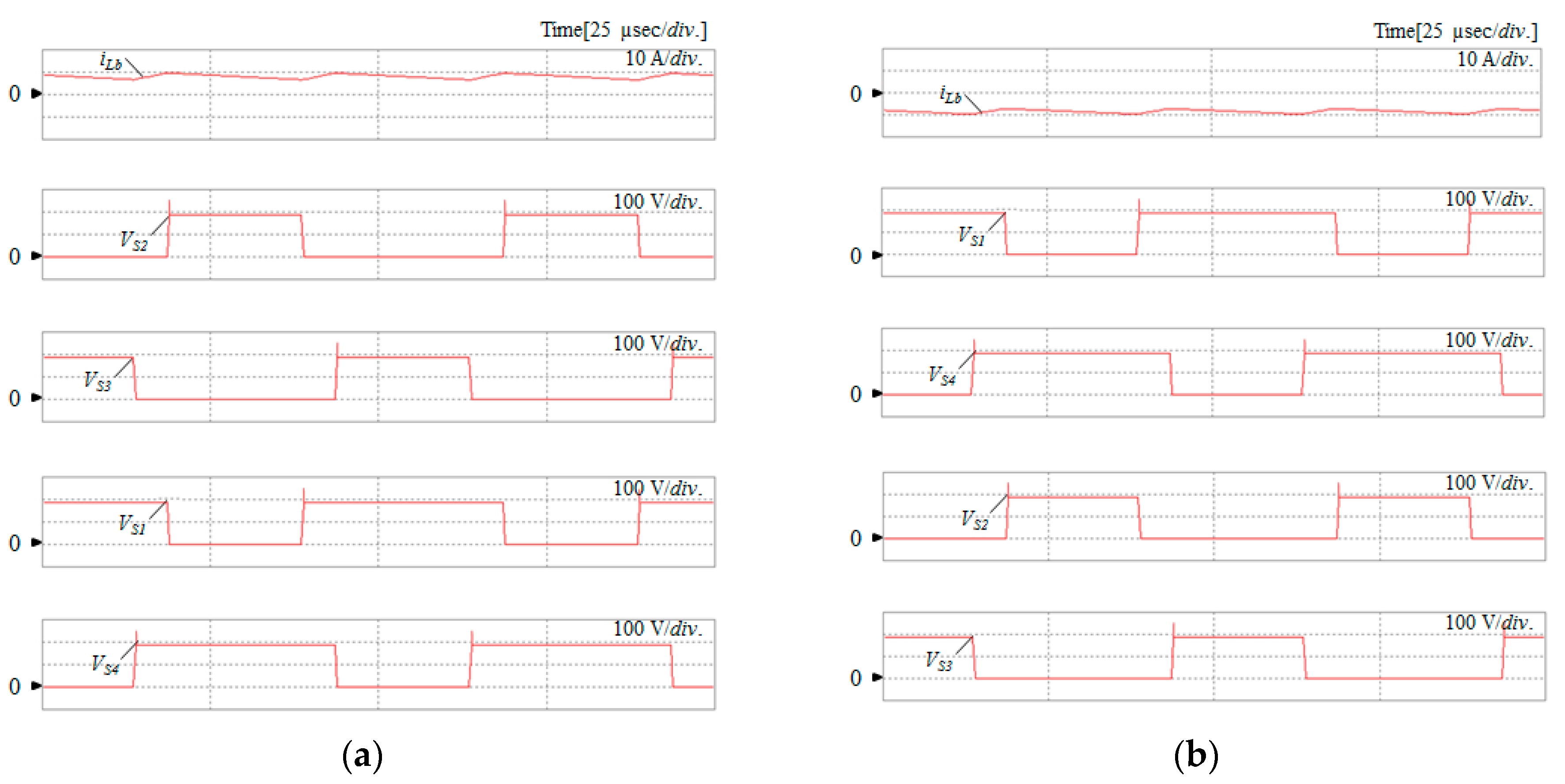

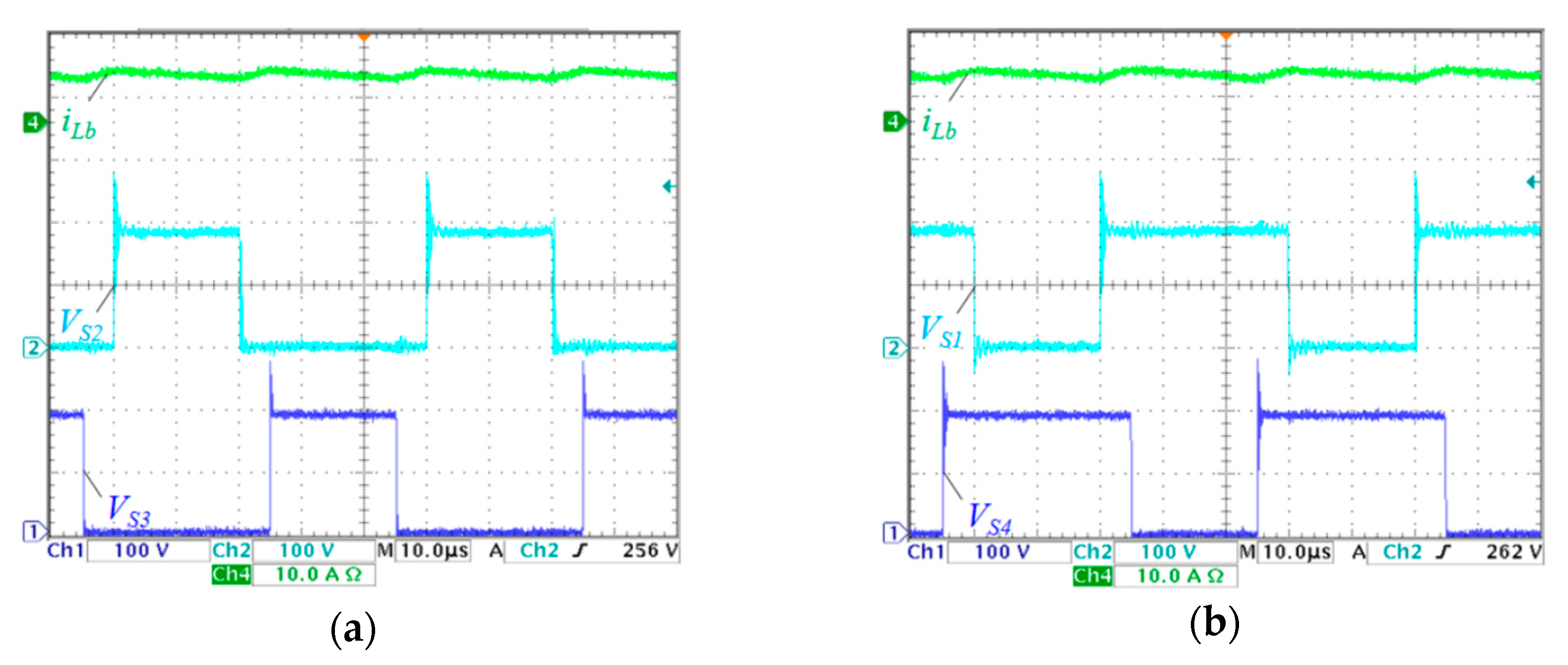
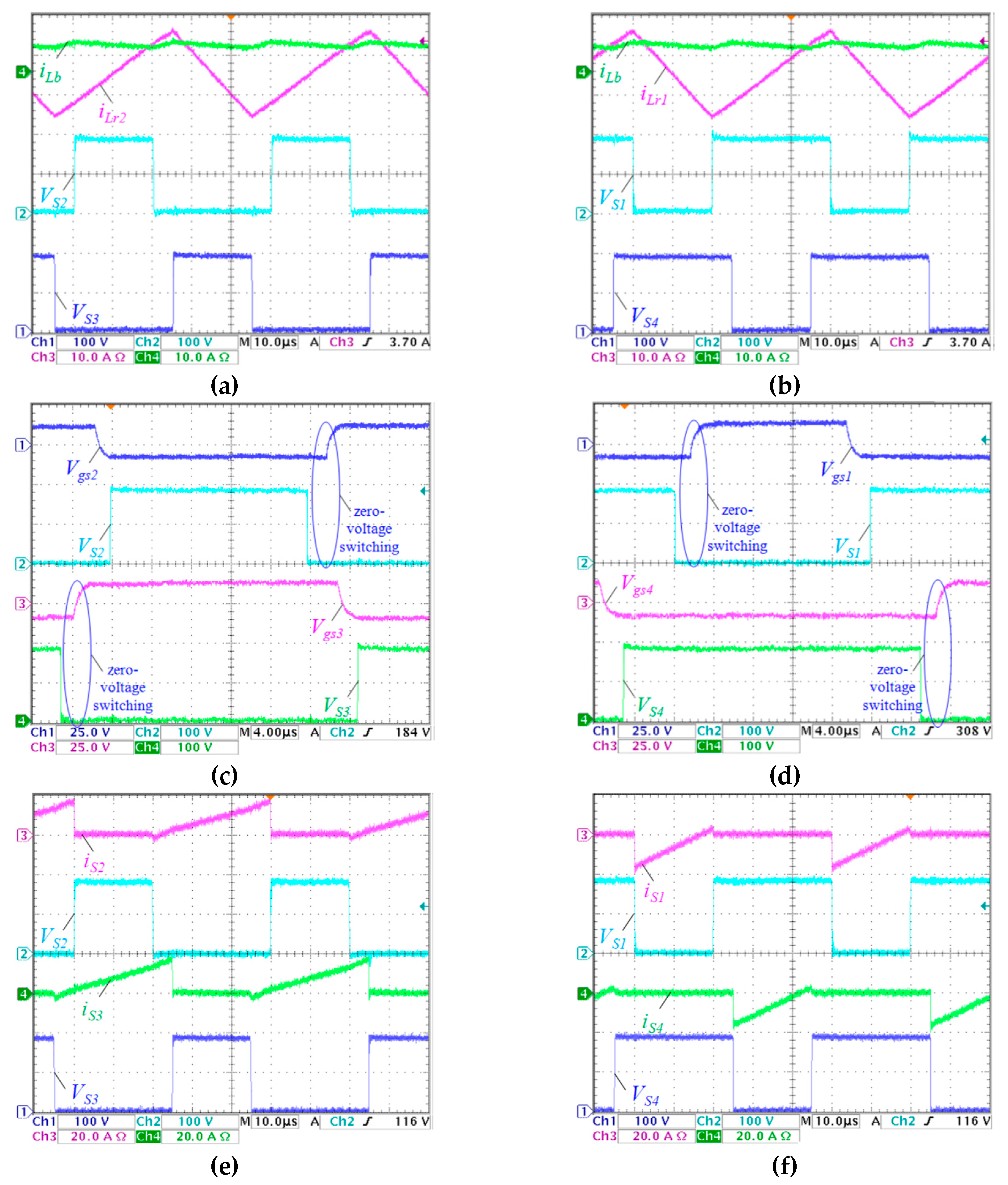

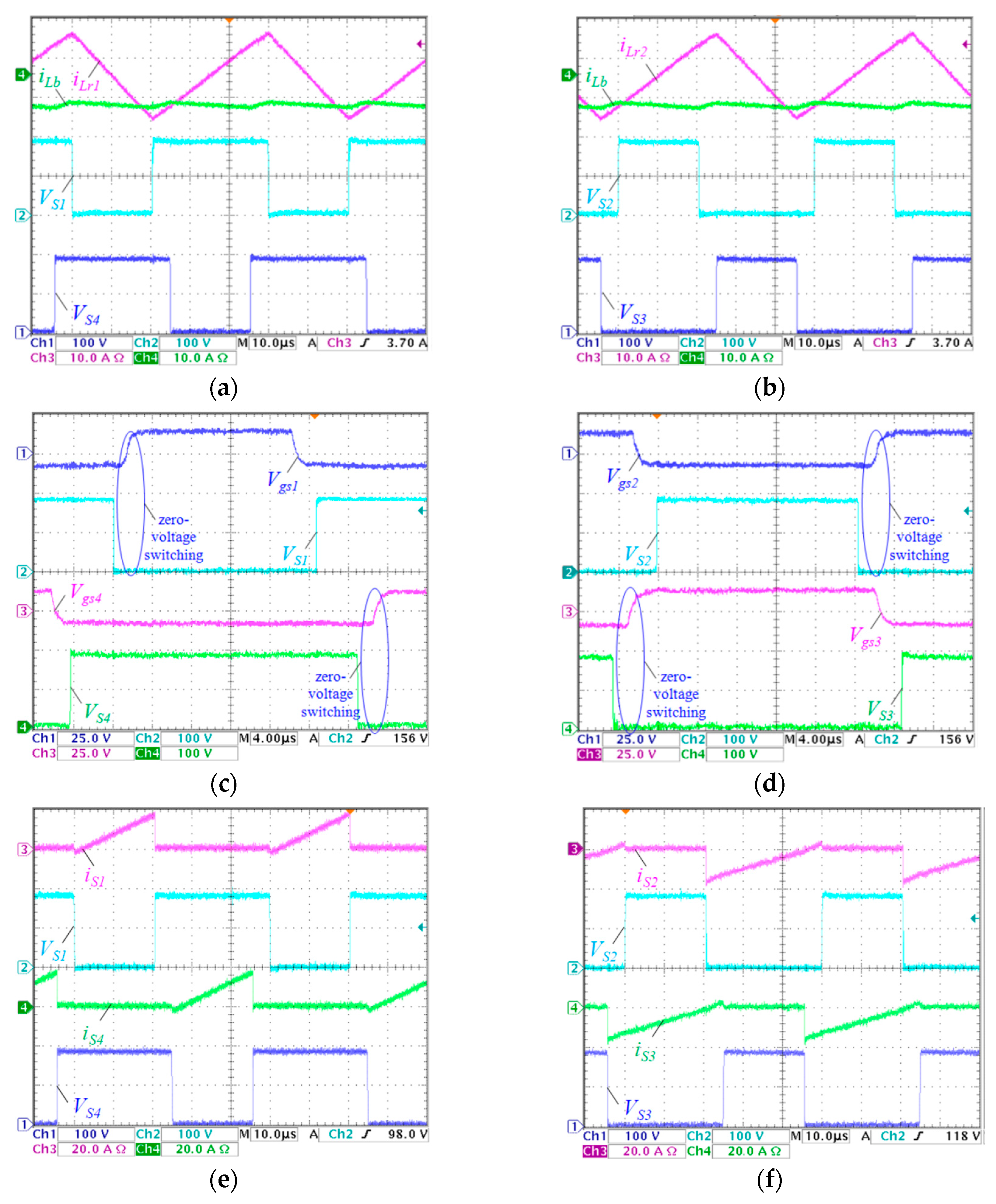

| Symbol | Quantity | Value |
|---|---|---|
| VL | low voltage | 140–160 V |
| VH | high voltage | 360–400 V |
| Pd | rated power | 1000 W |
| Ts | swiching period | 50 µsec |
| Td | dead time | 2 µsec |
| S1, S2, S3, S4 | power switch | IXFP30N25X3 |
| CS1, CS2, CS3, CS4 | capacitor | 1450 pF |
| Lb | inductor | 600 μH (CM508125) |
| Co1, Co2 | capacitor | 560 μF/450 V |
| Lr1, Lr2 | inductor | 100 μH (EE2828) |
| Cr1, Cr2 | capacitor | 2 μF/630 V |
| Step-Up Mode | Step-Down Mode | |||
|---|---|---|---|---|
| Conventional Converter | Proposed Converter | Conventional Converter | Proposed Converter | |
| Pturn_on | 11.0 W | 0 W | 10.4 W | 0 W |
| Pturn_off | 7.6 W | 9.6 W | 7.4 W | 9.2 W |
| Pcond | 7.4 W | 9.0 W | 7.2 W | 8.6 W |
| Pres_ind | 0 W | 1.4 W | 0 W | 1.2 W |
| Pothers | 3.0 W | 3.0 W | 3.0 W | 3.0 W |
| Ptotal | 29.0 W | 23.0 W | 28.0 W | 22.0 W |
© 2019 by the authors. Licensee MDPI, Basel, Switzerland. This article is an open access article distributed under the terms and conditions of the Creative Commons Attribution (CC BY) license (http://creativecommons.org/licenses/by/4.0/).
Share and Cite
Choi, W.-Y.; Yang, M.-K. Soft-Switching Bidirectional Three-Level DC–DC Converter with Simple Auxiliary Circuit. Electronics 2019, 8, 983. https://doi.org/10.3390/electronics8090983
Choi W-Y, Yang M-K. Soft-Switching Bidirectional Three-Level DC–DC Converter with Simple Auxiliary Circuit. Electronics. 2019; 8(9):983. https://doi.org/10.3390/electronics8090983
Chicago/Turabian StyleChoi, Woo-Young, and Min-Kwon Yang. 2019. "Soft-Switching Bidirectional Three-Level DC–DC Converter with Simple Auxiliary Circuit" Electronics 8, no. 9: 983. https://doi.org/10.3390/electronics8090983
APA StyleChoi, W.-Y., & Yang, M.-K. (2019). Soft-Switching Bidirectional Three-Level DC–DC Converter with Simple Auxiliary Circuit. Electronics, 8(9), 983. https://doi.org/10.3390/electronics8090983





